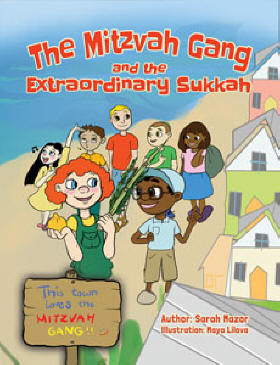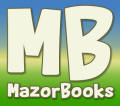
|
| • Holiday Gifts |
| Holiday Central > Sukkot > The Lulav and Etrog (Esrog) |
Sukkot: The Lulav and the Etrog
By: Rivka C. Berman, Contributor
Click Here for More Holiday Articles

|
CHILDREN'S BOOK for AGES 5-11 |
While the Sukkah hut gives the Sukkot holiday its name, this festival has two other main symbols: the lulav and etrog (esrog).
A lulav is a slender palm branch that is held together with two willow branches and three willow branches. An etrog (esrog) is a citron that looks mostly like a misshapen lemon but smells like heaven. The branches and fruit are waved each day Sukkot, except on Shabbat, in a specific manner for a variety of reasons.
From the Torah
The mitzvah to take
a lulav and etrog together on Sukkot comes from the Torah.
“On the first day you shall take the product of the beautiful (hadar)
tree, branches of palm trees, thick branches of leafy trees, and willows
of the brook and you shall rejoice before the Lord your God for seven
days” (Leviticus 23:40).
Other translations name the thick branches of leafy tees as “braided branches.” Myrtles are known as braided branches because their branches are thick with leaves that grow in sets of three. Each set overlaps the one above it, creating the appearance of a braid.
When the Temple stood in Jerusalem, the Jewish people used lulav and etrog on the first day. Only the Kohanim who served in the Temple used the lulav and etrog for the rest of the holiday. Once the Temple was destroyed, the rabbis decreed that all Jews should wave the lulav and etrog all seven days as a remembrance of Temple days.
A Deeper Look at the Lulav
Ismar Schorsch,
chancellor of the Conservative Movement’s Jewish Theological Seminary of
America, notes that just as the plants of the lulav cannot grow without
water, neither can we survive without God’s blessing.
Much like the symbolism of dwelling in a sukkah that is open to the
elements, this understanding of the lulav reinforces the message of Sukkot
that God provides our security and prosperity.
Earlier authorities examine the form of the lulav and etrog for clues about their meaning. A midrash in Vayikrah Rabba 30:12 explains the items as symbols of the importance of unity among different types of Jews. The etrog, a fruit, has both a flavor and a scent, like a Jew who is both learned and observant of the commandments. The lulav is from a date palm, and so it has a taste but no scent. It is likened to a Jew to is learned but does not apply that knowledge in action. A myrtle has a pleasant odor but there is nothing tasty about it, and it parallel is the Jew who has little book learning behind his or her observance. Finally the willow lacks both fragrance and food value, just like the Jew who neither studies the Torah nor keeps the commandments. The differences between Jews may be substantial, but, like the lulav and etrog which must be held together for the waving ritual, only when Jews come together do they merit a blessing.
Later in the same Midrash (ibid. 30:14) the rabbis use a quote from Psalms to riff on the lulav and etrog. “All my bones shall proclaim, ‘God, who can be likened to You!” The metaphor is applied in this way: the long straight lulav is likened to the spine. The tiny myrtle leaves become eyes, and the elongated willow leaves morph into lips. Bulbous and firm, the etrog is equated with the heart. As in the first example, holding all parts of the lulav and etrog together for the blessing informs the meaning of the metaphor. The secret ingredient to achieving the true happiness promised by Sukkot is to feel unity within, to be true to oneself and not say one thing and feel another.
Lulav and Etrog Rituals
There are many
different traditional ways to wave the lulav and etrog. Especially on the
first day this ritual is performed Halacha emphasizes that each person
should own the lulav and etrog he or she is waving.
If actually having one’s own set is impossible, “purchase”
the lulav and etrog by giving the true owner something of value.
After the waving the new owner may sell the lulav and etrog back.
Custom One
-
Face east.
- Take the lulav in the right hand and the etrog in the left.
Ashkenazic lefties take note, there
is a custom for southpaws to hold the lulav in the left hand and etrog in
the right. Sephardic Jews do
not make this change. Hold
the etrog stem side down. Be
sure to have the spine of the lulav facing the person holding it. The myrtle (the one with smallish leaves) should be on the
right and the willow should be on the left.
-
Say the blessing:
"Baruch ata Adonoy, Elo-heinu Melech ha'olam, asher kid'shanu bi'mitzvo-sav, vi'tzivanu al ni-tilat lulav."
Blessed are You, Lord our God, King of the Universe, who sanctified us with His mitzvot, and instructed us to raise up the Lulav. The first time you wave the lulav and etrog follow with the Shehechiyanu.
Baruch ata Adonoy, Elo-heinu Melech ha'olam, asher kid'shanu bi'mitzvo-sav, sheh-heh-khe-ya-nu v’ki-y’manu v’higi-anu la-z’man ha-zeh. Blessed are You, Lord our God, for giving us life, for sustaining us, and for enabling us to reach this season.
-
Turn the etrog stem side up.
-
With lulav and etrog in hand extend your arms out to the east and
back toward your heart three times. Then extend your arms to the south and back to your heart
three times. Follow the same
motions to the west, north, up and down.
Some people accompany the waving with the words “Hodu l’Adonai key tov, key l’olam khahs-doe.” “Let us give thanks to the Lord for God is good, for God’s kindness endures forever.”
-
Marching with the
Lulav and Etrog
As a memorial to a ceremony once held in the Temple, the morning services of Sukkot feature a lulav and etrog procession. While special verses of praise are chanted, worshippers circle around the synagogue or around the reading table and wave the lulav and etrog.
Lulav and Etrog Storage
Believe it or not
there are many varieties of lulav holders available.
Some look like super long plastic bags with zipper closures.
Others appear to ape a Star Wars motif and consist of two plastic
cones that fit together to form a sort of Sukkot light saber.
Silver carrying cases are also on the market.
Etrog storage is easier or trickier depending on the type of etrog being stored. Some etrog varieties arrive with a pitom, the stamen left over from the etrog blossom, protruding from the top. Be careful with the pitom. Should the pitom fall off, the etrog is no longer considered whole and should not be used for the mitzvah of waving the lulav. Many, if not most, etrogim (pl. etrog) are grown sans pitom. This saves much etrog-handling heartache. There is nothing wrong with keeping the etrog in the box it arrived in. The fibrous stuff surrounding the etrog is usually flax and cushions the etrog from bumps and bruises. Because of the desire to fulfill the commandments in a beautiful way, some Jews purchase special etrog holders made from wood, plastic, silver, metal, and pottery.

Mazor Guide for Sukkot brings you much more about the holiday, its meaning and its traditions... See the links below.
|
|
|
|

|
| • Holiday Gifts |
|
|
 |
| • Celebrations Gifts |
|
·
Wedding Gifts · Bar Mitzvah Gifts · Baby Gifts · Jewish Books at Great Prices |
KOSHER BY DESIGN Amazing New Kosher Cookbook. BUY |
Mazor Guides: Wealth of Information and Resources
- Mazor Guide - The Ultimate Guide to
Living Jewish -
- Guide to Jewish
Holidays -
-
Bar Mitzvah
and Bat Mitzvah Guide -
-
Guide to a
Jewish Wedding -
-
Guide to Jewish Celebrations -
-
Guide to Kosher Living -
- Infertility and
Judaism: A Guide -
- The Get (Gett)
- the Jewish Divorce: A Guide -
- Zei
Gezunt: Jewish Perspective on Health -
- Jewish Genetic Diseases -
-
Death and Mourning in
Judaism -
Copyright 1998-2024 MazorNet, Inc.
| http://www.MazorGuide.com | http://www.MazorBooks.com | http://www.Kosher-Directory.com | http://www.JewishCelebrations.com






